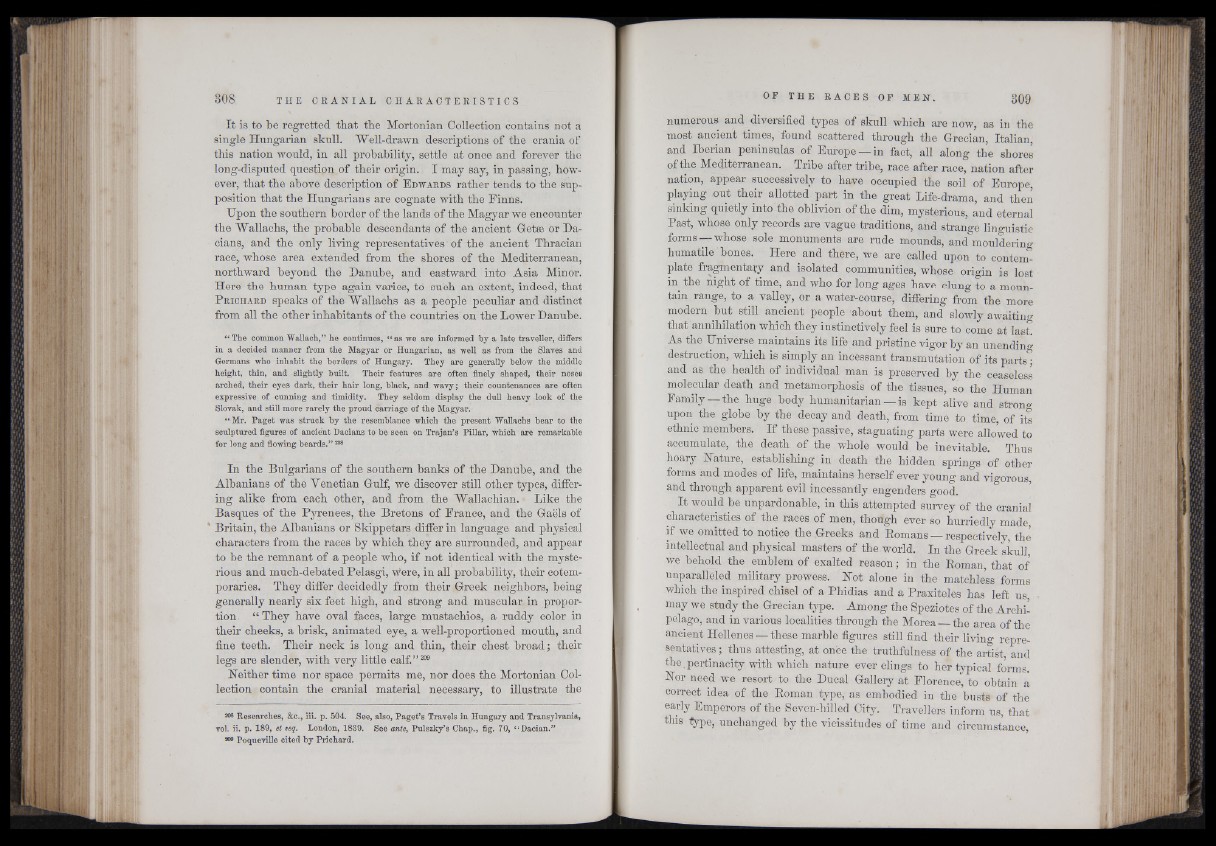
It is to be regretted that the Mortonian Collection contains not a
single Hungarian skull. "Well-drawn descriptions of the crania of
this nation would, in all probability, settle at once and forever the
long-disputed question of their origin. I may say, in passing, however,
that the above description of E dwards rather tends to the supposition
that the Hungarians are cognate with the Finns.
Upon the southern border of the lands of the Magyar we encounter
the Wallachs, the probable descendants of the ancient Getse or Dacians,
and the only living representatives of the ancient Thracian
race, whose area extended from the shores of the Mediterranean,
northward beyond the Danube, and eastward into Asia Minor.
Here the human type again varies, to such an extent, indeed, that
P rich a r d speaks of the Wallachs as a people peculiar and distinct
from all the other inhabitants of the countries on the Lower Danube.
“ The common Wallach,” he continues, “ as we are informed by a late traveller, differs
in a decided manner from the Magyar or Hungarian, as well as from the Slaves and
Germans who inhabit the borders of Hungary. They are generally below the middle
height, thin, and slightly built. Their features are often finely shaped, their noses
arched, their eyes dark, their hair long, black, and wavy; their countenances are often
expressive of cunning and timidity. They seldom display the dull heavy look of the
Slovak, and still more rarely the proud carriage of the Magyar.
“ Mr. Paget was struck by the resemblance which the present Wallachs bear to the
sculptured figures of ancient Dacians to be seen on Trajan’s Pillar, which are remarkable
for long and flowing beards.” 208
In the Bulgarians of the southern banks of the Danube, and the
Albanians of the Venetian Gulf, we discover still other types, differing
alike from each other, and from the Wallachian. Like the
Basques of the Pyrenees, the Bretons of France, and the Gaels of
Britain, the Albanians or Skippetars differ in language and physical
characters from the races by which they are surrounded, and appear
to be the remnant of a people who, if not identical with the mysterious
and much-debated Pelasgi, 'were, in all probability, their cotemporaries.
They differ decidedly from their Greek neighbors, being
generally nearly six feet high, and strong and muscular in proportion:
“ They have oval faces, large mustachios, a ruddy color in
their cheeks, a brisk, animated eye, a well-proportioned mouth, and
fine teeth. Their neck is long and thin, their chest broad; their
legs are slender, with very little calf.”209
Heither time nor space permits me, nor does the Mortonian Collection
contain the cranial material necessary, to illustrate the
208 Researches, &c., iii. p. 504. See, also, Paget’s Travels in Hungary and Transylvania,
vol. ii. p. 189, et seq. London, 1839. See awte, Pulszky’s Chap., fig. 70, “ Daoian.”
209 Poqueville cited by Prichard.
numerous and diversified types of skull which are now, as in the
most ancient times, found scattered through the Grecian, Italian
and Iberian peninsulas of Europe —in fact, all along the shores
of the Mediterranean. Tribe after tribe, race after race, nation after
nation, appear successively to have occupied the soil of Europe,
playing out their allotted part in the great Life-drama, and then
sinking quietly into the oblivion of the dim, mysterious, and eternal
Past, whose only records are vague traditions, and strange linguistic
forms —whose sole monuments are rude mounds, and mouldering
humatile bones. Here and there, we are called upon to contemplate
fragmentary and isolated communities, whose origin is lost
in the night of time, and who for long ages have clung to a mountain
range, to a valley, or a water-course, differing from the more
modem but still ancient people 'about them, and slowly awaitino-
that annihilation which they instinctively feel is sure to come at last.
As the Universe maintains its life and pristine vigor by an unending
destruction, which is simply an incessant transmutation of its parts;
and as the health of individual man is preserved by the ceaseless
molecular death and metamorphosis of the tissues, so the Human
Family —the huge body humanitarian —is, kept alive and strong
upon the globe by the decay and death, from time to time, of its
ethnic members. If these passive, stagnating parts were allowed to
accumulate, the death of the whole would be inevitable. Thus
hoary Nature, establishing in death the hidden springs of other
forms and modes pf life, maintains herself ever young and vigorous
and through apparent evil incessantly engenders good.
It would be unpardonable, in this attempted survey of the cranial
characteristics of the races of men, though ever so hurriedly made
if we omitted to notice the Greeks and Bomans — respectively, the
intellectual and physical masters of the world. In the Greek skull,
we behold the emblem of exalted reason; in the Roman, that of
unparalleled military prowess. Not alone in the matchless forms
which the inspired chisel of a Phidias and a Praxiteles has left us .
may we study the Grecian type. Among the Speziotes of the Archipelago,
and in various localities through the Morea — the area of the
ancient Hellenes —these marble figures still find their living representatives
; thus attesting, at once the truthfulness of the artist, and
the.pertinacity with which nature ever clings to her typical forms.
Nor need we resort to the Ducal Gallery at Florence, to obtain a
correct idea of the Roman type, as embodied in the busts of the
early Emperors of the Seven-hilled City. Travellers inform us, that
this type, unchanged by the vicissitudes of time and circumstance,